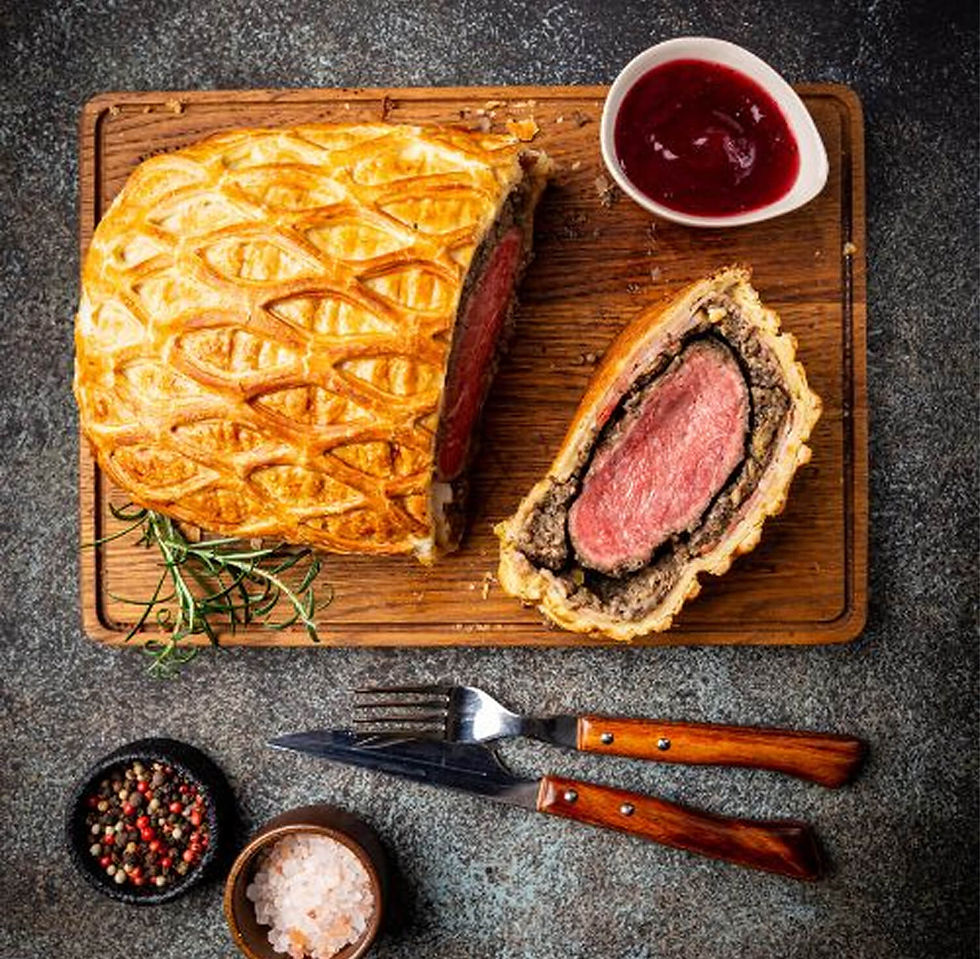Salmon—One of America’s Most Popular Fish
- Aug 6, 2021
- 5 min read

When you are standing in front of the fish counter at your supermarket, do you ever wondered, “Which variety of salmon should I purchase?” It can be quite puzzling. What exactly is the difference between wild and farm-raised salmon and Pacific and Atlantic salmon?
Wild salmon is caught in its natural environment like oceans, rivers, or lakes and eats a diet consistent with its surroundings. Farm-raised salmon is farmed using a process called aquaculture, where the fish are given a processed feed that is high in fat and protein designed to make them grow larger.
There are five types of Pacific salmon:
Salmon connoisseurs agree that wild salmon is the most flavorful; nutritionists find it contains more minerals than farm-raised fish and is a good source of Omega-3’s, and food purists believe it contains the least contaminants. It is also pricier than Atlantic salmon. This year the Cordova Times reported King salmon could sell for as much as $80 per pound and sockeye as much as $54 per pound.
King or Chinook is one of the rarest variety of salmon and with its rich, buttery flavor is considered the best salmon money can buy. A King salmon can weigh anywhere between 40 to 130 pounds. Because of its size, this variety is cut into thick fillets; and if you are looking for a fish that contains lots of Omega-3’s, chose this variety. King salmon is found along the cost of Central California all the way to Alaska and even into Asia. When caught in prestigious rivers like the Columbia or Copper, King salmon can be very pricey. If the price per pound doesn’t break your pocketbook, purchase King salmon.
Sockeye or Red salmon are mostly caught in Alaskan waters and are generally smaller and leaner than Kings. They possess a striking red-orange flesh, a salmony taste, and a moderate amount of fat. Because they are generally less expensive than King or Coho, sockeye salmon are very popular with salmon lovers.
Coho or Silver salmon has a bright silver skin and a more subtle, delicate flavor. Because it is smaller than some salmon, Cohos are used when cooking a whole fish. While their flavor is similar to King salmon, their texture is more delicate, and they have less fat content.
Pink or Humpback salmon have a distinctive hump on their back that develops when they spawn. The pink or humpback salmon is typically processed and sold in cans or pouches. Chum or Silverbrite (Keta or Dog), mostly found in Alaskan waters, is a light to medium-colored fish that is most prized for its roe, considered a delicacy in many cuisines. Chum’s roe can be bigger and tastier than the roe of other varieties of salmon. This salmon gets its name from its dog-like teeth.
Atlantic Salmon Atlantic salmon is normally the most reasonably priced. While there are salmon lovers who prefer the taste of Atlantic salmon, its price point is its strongest suit. Nutritionists find that farm-raised salmon is higher in vitamin C, saturated fat, and calories than wild salmon. Both are excellent sources of Omega 3’s. Atlantic salmon has a milder flavor than Pacific salmon and is often larger in size because of the diet it is fed.
There are very few wild Atlantic salmon in existence today—it is all farm-raised. Dams in the Northeast United Stated have prohibited salmon from swimming upriver and spawning. While there are a few Atlantic fish farms in the United States, most of our Atlantic salmon is imported from Canada, South America (primarily Chile), or Europe (primarily Norway). Norwegian salmon are raised in a natural habitat, unlike Chilean salmon where fish are raised in cramped pools. Also, Norway is committed to stricter regulations.
While fish farming has improved over the years with more fisheries feeding their fish plant-based food better formulated for good health, if I am buying Atlantic salmon, I prefer Norwegian.
If you love salmon and are looking for something out of the ordinary, I’ve created a new recipe for my favorite fish —Wasabi Pea Encrusted Salmon Sandwiches with an Asian Mayonnaise.
Wasabi peas are made from large, dried peas that are hollowed out by removing their inner meat. A powdered form of wasabi, sometimes called Japanese horseradish, is mixed with water producing a paste-like solution. The hollowed peas are coated with the wasabi paste and then dried again, causing the wasabi paste to harden. This process turns green peas into a hot, spicy treat. I love eating wasabi peas out of hand like chips or nuts; and, when I get bored with some of my standby salad recipes, especially those with an Asian flair, I spice them up with these tasty wonders.
I’ve created a sandwich recipe using my favorite fish and my favorite snack. There are certain evenings during the summer when nothing hits the spot quite like a sandwich, and this one is to die for. It’s a bit of a Dagwood but absolutely delicious.
Wasabi Pea Encrusted Salmon Sandwiches
with Asian Mayonnaise
Serves 4
For the Asian mayonnaise:
1 cup mayonnaise
1 teaspoon soy sauce
1 green onion, thinly sliced
1 teaspoon sesame seeds
Sea salt to taste
Large grind black pepper to taste
In a small bowl, combine mayonnaise, soy sauce, green onion, and sesame seeds and whisk to blend. Season to taste with salt and pepper. Cover with plastic wrap and refrigerate until ready to serve.
For the fish:
4 (6-ounce) salmon fillets, 1 to 1 ½ inches thick, skin removed
Extra virgin olive oil for brushing
1 cup wasabi peas
¼ cup Panko (Japanese) breadcrumbs
2 tablespoons olive oil
2 tablespoons unsalted butter
4 mini baguettes, or your favorite sandwich buns
4 to 8 butterhead lettuce leaves
2 ripe tomatoes, sliced into 8 slices
Using a pastry brush, brush both sides of salmon fillets with olive oil. Place wasabi peas in a blender and process until they are the consistency of breadcrumbs. Spread ground peas on a plate. Dip both sides of fillets into peas, pressing gently to coat evenly. In a large, nonstick skillet, place olive oil and butter over medium heat. Place fillets flesh-side down in the skillet and cook for 4 minutes, or until the crust becomes crisp and starts to brown lightly. Using a spatula, carefully lift the edge of each fillet to ensure it is not burning. Lower heat if fish browns too quickly. With the same spatula, turn fillets and continue to cook another 4 minutes, or until fillets are medium rare. Transfer to a paper towel to drain.
Using a sharp knife, cut rolls in half. Spread each half with Asian mayonnaise to taste. Place lettuce leaves, 2 tomato slices, and piece of salmon on bottom half of each roll. Top with the other half of roll. Serve immediately with any additional Asian mayonnaise on the side.
Shopping for salmon: To purchase really fresh salmon, shop with your nose. Fresh fish never smells “fishy” but has a fresh, mild order. Fish only smells “fishy” or like ammonia when it starts to decompose. Also, shop with your eyes. Fresh fish should have a firm texture and moist appearance. Avoid fish that is dry or brown around the edges. Always buy fresh fish that has been refrigerated or properly iced. The best fish is the freshest, no more than 2 to 3 days out of the water.
Carol Ann

Carol Ann Kates is the award-winning author of cookbook, Secret Recipes from the Corner Market and Insider Grocery Shopping Secrets. She’s an expert in how to shop, select, and store produce for maximizing home cooking outcomes and minimizing time and money spent. As a former supermarket and deli operator, Carol Ann shares grocery-insider wisdom—the same expertise you used to receive when patronizing a mom-and-pop establishment. Contact her at CarolAnn@CarolAnnKates.com and explore her website, www.CarolAnnKates.com.
Copyright 2021 All Rights Reserved Carol Ann Kates
1
Searing the Beef
Sear beef fillets on high heat for 2 minutes per side to form a golden crust. Let it cool before proceeding to keep the beef tender.
1
Searing the Beef
Sear beef fillets on high heat for 2 minutes per side to form a golden crust. Let it cool before proceeding to keep the beef tender.
1
Searing the Beef
Sear beef fillets on high heat for 2 minutes per side to form a golden crust. Let it cool before proceeding to keep the beef tender.
1
Searing the Beef
Sear beef fillets on high heat for 2 minutes per side to form a golden crust. Let it cool before proceeding to keep the beef tender.
Notes



1
Season the good fresh beef fillets with salt and black pepper. Heat olive oil in a pan over high heat and sear the fillets for 2 minutes per side until it fully browned. Remove the beef from the pan and brush with a thin layer of mustard. Let it cool.



1
Season the good fresh beef fillets with salt and black pepper. Heat olive oil in a pan over high heat and sear the fillets for 2 minutes per side until it fully browned. Remove the beef from the pan and brush with a thin layer of mustard. Let it cool.



1
Season the good fresh beef fillets with salt and black pepper. Heat olive oil in a pan over high heat and sear the fillets for 2 minutes per side until it fully browned. Remove the beef from the pan and brush with a thin layer of mustard. Let it cool.



1
Season the good fresh beef fillets with salt and black pepper. Heat olive oil in a pan over high heat and sear the fillets for 2 minutes per side until it fully browned. Remove the beef from the pan and brush with a thin layer of mustard. Let it cool.
Instructions
Quality Fresh 2 beef fillets ( approximately 14 ounces each )
Quality Fresh 2 beef fillets ( approximately 14 ounces each )
Quality Fresh 2 beef fillets ( approximately 14 ounces each )
Beef Wellington

Beef Wellington
Fusion Wizard - Rooftop Eatery in Tokyo
Author Name

Beef Wellington is a luxurious dish featuring tender beef fillet coated with a flavorful mushroom duxelles and wrapped in a golden, flaky puff pastry. Perfect for special occasions, this recipe combines rich flavors and impressive presentation, making it the ultimate centerpiece for any celebration.
Servings :
4 Servings
Calories:
813 calories / Serve
Prep Time
30 mins
Prep Time
30 mins
Prep Time
30 mins
Prep Time
30 mins










Comments